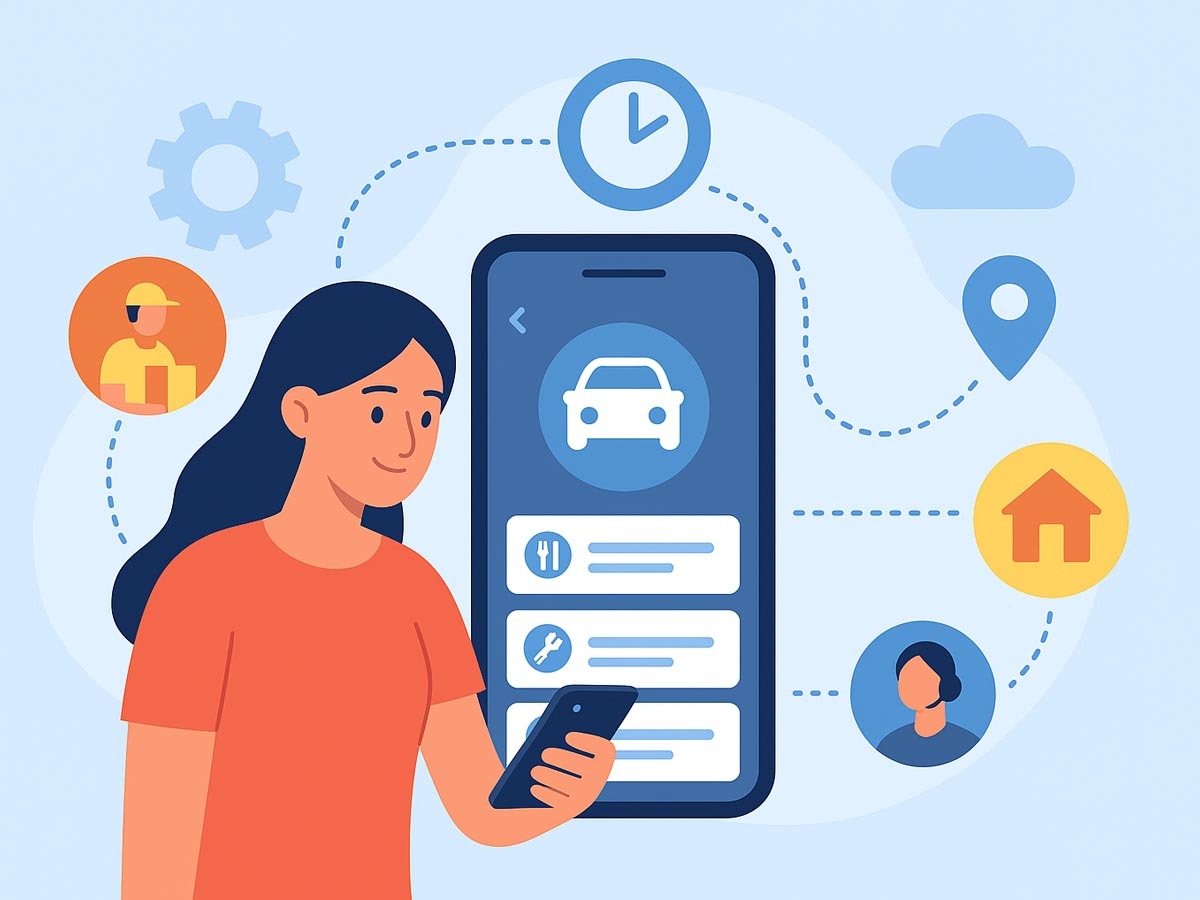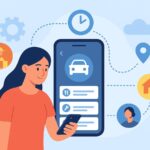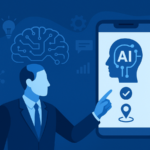How Multi-Agent AI Systems Are Powering On-Demand Apps

-
Ankit Patel
- November 11, 2025
- 5 min read
One AI agent can answer a question. But can it handle the chaos of real-time demand, delivery delays, balance supply, and customer feedback—all happening at once?
That’s the challenge behind most on-demand apps today. A single model can automate a process, but it often can’t reason across multiple workflows or adapt to fast-changing conditions.
As on-demand platforms grow more complex, the limits of single-agent systems become clear. They react—but they don’t plan. They respond—but they don’t coordinate.
That’s where multi-agent AI systems come in.
Instead of one large model trying to do everything, multi-agent systems use multiple intelligent agents—each with a distinct role—to think, decide, and act together. One agent predicts demand spikes. Another optimizes delivery routes. A third manages customer feedback. They collaborate, critique each other, and continuously improve—much like a well-coordinated human team.
This shift marks a new phase in AI-driven innovation: moving from assistance to autonomy, from automation to orchestration.
In this blog, we’ll explore how multi-agent AI systems power on-demand apps, when they’re needed, how they scale complex platforms, and what their architecture looks like.
◉ From Automation to Intelligence
A few years ago, most on-demand apps relied on single-purpose AI tools: route optimization, demand forecasting, or chatbot-based customer support. These tools were efficient but reactive. They responded when triggered, but they didn’t think beyond the immediate request.
As businesses scaled, they needed more. They wanted apps that could not only respond but also anticipate. That could reason, plan, and coordinate multiple operations in real time.
That’s where multi-agent AI systems emerged—a framework where autonomous AI agents collaborate, each handling a distinct function while sharing insights to achieve a common goal.
What Are Multi-Agent AI Systems?
In simple terms, a multi-agent AI system is a team of intelligent agents—each designed to perform a specific task but capable of communicating and collaborating with others.
For example, in an on-demand food delivery app:
- One agent predicts order surges.
- Another assigns drivers.
- A third manages real-time delivery tracking.
- A fourth monitors customer satisfaction.
Each agent has autonomy, but they work together through a shared system architecture. It’s like an invisible operations team running millions of micro-decisions every second.
According to Gartner, by 2026, 40% of enterprise applications will feature task-specific AI agents—up from less than 5% in 2025.
That shift signals the beginning of a new era in AI-driven on-demand solutions.
◉ When Single AI Agents Work
Solo agents work best when the task is simple, predictable, and linear. For instance:
- Fetching a user’s past orders.
- Sending automated notifications.
- Providing basic customer support responses.
In these scenarios, one agent can handle the job from start to finish without coordination.
Single-agent systems are easier to manage, require less infrastructure, and are ideal for early-stage startups or limited-scope operations.
But as your app starts managing thousands of users, real-time logistics, or multiple service types, a solo agent can’t keep up.
◉ When Single Agents Fall Short
Let’s say your on-demand platform handles food delivery, home cleaning, and package drop-offs.
A solo agent might do fine processing one type of request. But once it needs to handle multiple workflows, contexts, and data sources simultaneously, performance drops.
It starts missing context—assigning the wrong driver, delaying responses, or failing to adapt pricing in real time.
The issue isn’t bad AI—it’s overloaded AI. You’re asking one system to reason, plan, optimize, and execute everything in a single loop.
That’s when the switch to a multi-agent system becomes not just smart, but necessary.
◉ How Multi-Agent AI Systems Scale On-Demand Platforms
In a multi-agent system, each agent specializes in one part of the workflow. Together, they form an adaptive network capable of managing large-scale operations.
Here’s what that looks like in an on-demand context:
| Agent | Core Role | Example |
| Demand Agent | Predicts surge times | Detects lunch-hour order spikes |
| Dispatch Agent | Assigns drivers/providers | Matches users to nearby partners |
| Pricing Agent | Adjusts rates dynamically | Increases prices during high demand |
| Routing Agent | Optimizes delivery paths | Finds fastest delivery routes |
| Feedback Agent | Monitors user satisfaction | Detects and resolves low ratings |
Each agent communicates with others, shares results, and adapts decisions in real time.
According to Glide’s Report, 47% of AI-enabled businesses now use multiple AI agents, with most deploying between 2–10 specialized agents per system.
That collaboration is what keeps complex on-demand platforms running smoothly—even during heavy load.

◉ The Architecture Behind Multi-Agent AI
An effective AI system architecture for an on-demand platform is built like a living ecosystem—each agent handles one function but connects to others through clear communication channels.
In our on-demand platforms, we typically structure agents like this:
- User Interaction Agent: Understands user intent (“Book a car now”) and translates it into an actionable request.
- Matching Agent: Finds the most suitable provider (driver, technician, delivery partner).
- Scheduling Agent: Plans optimal routes and times.
- Pricing Agent: Adjusts prices based on current supply and demand.
- Notification Agent: Sends updates and reminders to users and providers.
- Feedback Agent: Collects reviews, monitors quality, and reports trends.
- Security Agent: Protects data and transactions.
This modular design ensures scalability; new agents can be added without rebuilding the entire system.
◉ Real-World Use Cases of Multi-Agent AI Systems
You might not realize it, but if you’ve used an on-demand service today, you’ve probably already interacted with a multi-agent AI system.
Here are some real-world examples:
• Ride-Hailing Apps
When you request a ride, one agent finds nearby drivers, another calculates dynamic pricing, a third plans the fastest route, and another monitors your trip. Uber’s system reportedly handles millions of ride matches daily using AI-based dispatching.
Read also: AI-Powered Taxi App Development: A Complete Guide
• Food Delivery Platforms
DoorDash and other delivery services use AI for route optimization, predicting delivery times, and balancing workload among drivers. This AI-driven coordination has helped improve delivery efficiency and reduce delays.
• On-Demand Home Services
Platforms for cleaning, repairs, or personal care use multiple AI-driven components to verify providers, schedule appointments, and maintain quality checks—ensuring reliability and trust for customers.
• Healthcare & Telemedicine
AI helps with patient triage, doctor matching, and appointment scheduling, improving efficiency while supporting privacy compliance. Multi-agent approaches are emerging to scale telemedicine services.
These examples show how AI-driven on-demand solutions are quietly transforming industries behind the scenes.
◉ Benefits of Multi-Agent AI for On-Demand Platforms
So, why are so many businesses moving toward this model? The benefits are practical, measurable, and long-term.
- Faster Decision-Making: Because agents work in parallel, on-demand platforms respond faster—reducing wait times for users and boosting satisfaction.
- Better Reliability: If one module fails, others continue operating. This ensures your app stays live even during traffic surges or outages.
- Easier Scalability: Adding new cities, services, or features becomes simpler. Just create or replicate agents instead of rebuilding entire systems.
- Smarter Automation: Routine tasks like dispatching, scheduling, and monitoring can run automatically. Teams focus on innovation instead of maintenance.
- Personalization: Agents can learn user behavior—what time you usually order food or where you prefer pickup—and adjust experiences accordingly.

◉ How PeppyOcean Builds Scalable AI-Driven On-Demand Apps
At PeppyOcean, we’ve seen firsthand how multi-agent systems can transform on-demand businesses. Our approach to on-demand app development blends deep AI expertise with practical scalability.
Here’s how we typically build AI-driven platforms:
Step 1: Understanding the Business Model
Every on-demand idea is unique. We start by mapping your operations—who your users are, what services you offer, and what challenges you face (for example, unpredictable demand or delayed matching).
Step 2: Designing the Agent Framework
Next, we design the right mix of agents. For a delivery app, this could include a matching agent, pricing agent, and logistics agent. For a healthcare platform, it could include patient triage and doctor allocation agents.
Step 3: Building Scalable Architecture
We develop an architecture that supports growth—microservices, APIs, and databases designed for speed, fault tolerance, and data security.
Step 4: Implementing AI Automation
We integrate automation into key workflows: dispatching, route optimization, or notifications. This reduces human intervention and increases accuracy.
Step 5: Testing & Continuous Learning
Once deployed, we monitor how agents perform in real conditions. They continuously learn and improve through user feedback and behavioral data.
◉ Final Thoughts
The on-demand world moves fast, too fast for single AI systems to keep up alone. Multi-agent AI systems bring structure to that speed. They divide complexity, share intelligence, and work together to make every decision smarter than the last.
This shift isn’t just technical—it’s strategic. The future of on-demand apps belongs to platforms that think like teams, not machines. In that future, every tap, every delivery, every interaction will be guided by networks of intelligent agents quietly collaborating in real time.
Ready to revolutionize your on-demand business?
Connect with us to build adaptive, scalable platforms that think faster and deliver smarter results.
You may also like

How Much Does It Cost to Build an App Like Teladoc?
-
Ankit Patel
The world of healthcare is changing faster than ever. Patients no longer want to wait in long lines or travel miles just to meet a doctor. They want quick, remote access to trusted healthcare services — and that’s exactly what Teladoc offers. Apps like Teladoc have made it possible to consult doctors from the comfort… Read More

How Much Does It Cost to Develop a Telemedicine App?
-
Ankit Patel
A decade ago, seeing a doctor meant hours in a waiting room, piles of paperwork, and endless phone calls. For millions of people in rural areas, even basic medical care was a luxury. Patients had to travel long distances, lose work hours, and hope that their medical history was accurate and available. Today, healthcare looks… Read More

Doctor On-Demand: How AI Is Transforming Virtual Healthcare
-
Ankit Patel
Think back to a time when visiting the doctor meant long waits, crowded hospitals, and rushed consultations. For decades, this was the only option patients had. But the world is changing. People now expect the same convenience from healthcare that they already enjoy in food delivery, online shopping, or ride-hailing. Healthcare is no longer just… Read More






